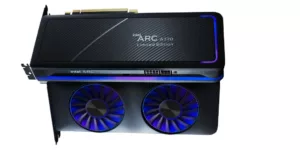Last week at Intel Innovation, Intel released its first discrete graphics card. It’s nice looking, but can it compete with AMD’s and NVIDIA’s best offerings? The answer is no.
But it would have been impossible for Intel to come up with a new card that beat the best from two companies that have been running hard against each other in that segment for decades. So, Intel came up with a different strategy: create a card that is solidly in the value space with regards to pricing but provides it with features that are often only found in premium cards. This not only potentially provides a lot of value where the volumes are typically higher, but competitors won’t want to respond for fear of devaluing their higher-end offerings.
Now, this is a new card which means there will be growing pains. If you aren’t into first-generation technology teething problems, you’d best wait a few months so that any driver or incompatibility issues are addressed by others. But for those that want a decent level of performance in an affordable graphics card, the Intel Arc A770 is for you.
The strategy is very similar to how Japanese and Korean car makers came to market. They hit low price points with cars that had features often not found until you got to premium offerings to establish themselves in the market, then brought out ever more capable products over time. This strategy allowed Toyota to eventually challenge and take leadership from General Motors.
Let’s talk about Intel’s Arc A770 Limited Edition discrete graphics card this week.
Perception and reality
A good marketing program focuses on the perception of the related product because, to the buyer, perception is reality. The new Intel Arc A770 Limited Edition card leads with perception. Limited editions are typically the first cards to market at the high end of any line and are often relatively unaffordable since they go for a significant premium.
In its most expensive configuration, the Arc A770 Limited Edition card is only $349 which is a $20 increase over the base card and the real value. The difference between the two cards is 8 GB of memory. The reason to have both is to create the impression in the mind of the buyer that $20 but 8 gigs of memory you can’t upgrade is one great deal.
Exclusivity tends to connect to buyer status, and status drives sales. This is at the core of Intel’s naming gambit. They don’t have cards in the nose-bleed pricing segments, thus the card they do have is their flagship. Typically, such a move would devalue more expensive cards, but Intel doesn’t have those which allow them to put features in this card like XeSS, Smooth Sync, Speed Sync, and Arc Control that you’d typically find in more expensive offerings.
Performance
Due to its new technology, Intel’s Arc card performs best with the latest games that take into account the XeSS up converter. This accounts for a lot of the current AAA titles, but older titles that were created before this card was released won’t perform as well. One of the most thorough benchmarks for this new card can be found at PCMag which confirms that with current games, the card over achieves, but with old games, it underperforms its competitors. However, once those older games are updated, it is likely their support for this new card will also increase.
The key is the XeSS support which allows the related system to render at low resolutions, then upscaling the result. But if the game doesn’t support XeSS, it will be hampered competitively, and the related performance will be lower than with other similar cards. The gameplay isn’t horrible, but clearly, this card is best for those playing current titles until the older titles are updated for this new upscaling technology.
Wrapping up:
For early adopters, the Intel Arc A770 Limited Edition looks to be good value, but that value will increase as more game developers embrace its unique upscaling technology. It is a pretty card in a case and will visually enhance most any system built that has a window into the case to see it. At $349 it is one of the best desktop PC values in the market, but higher-end cards from both NVIDIA and AMD will outperform it. For many, however, that extra performance may be financially undesirable or not needed depending on the game title.
As is always my advice with brand new products, it would be wise to wait a few months before buying this card so that any problems are discovered by others. So far, even the most rigorous testing hasn’t identified a major problem, only tuning issues, but there’s almost always breakage when a new technology like this rolls out. The real test will come when thousands of people use the card.
Best of luck and good gaming!








